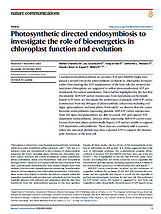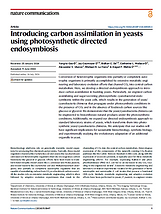Directed endosymbiosis
for evolutionary studies and synthetic biology
Chloroplasts are the key photosynthetic organelles in plants and green algal cells, and thereby an integral part of the global ecosystem. Endosymbiotic theory suggests that mitochondria and chloroplasts evolved from free-living prokaryotes which entered the host cell and were retained as endosymbionts; however, there is a minimal understanding of how a free living bacteria evolved and transformed in to cell entrapped organelle.
Directed endosymbiosis to uncover the molecular details of organelle evolution:
Inspired by these remarkable evolutionary observations, we engineered artificial endosymbiosis between cyanobacteria and yeast cells to generate photosynthetic yeast/cyanobacteria life-forms. Our studies focus on recapitulating various stages of chloroplast evolution including but not limited to (i) cyanobacterial endosymbiont genome minimization, (ii) engineer cyanobacterial endosymbionts to secrete photosynthetic end-products, (iii) cell cycle synchronization of the host and the endosymbiont (iv) develop strategies to facilitate protein exchange between the endosymbiont and host and (v) mutation-based evolution and selection. These studies are expected to provide molecular level insights into the transformation of free-living bacteria into entrapped organelles. Further, we plan on expanding this platform for various synthetic biology applications involving photosynthetic metabolic engineering and carbon dioxide sequestration.
Biosynthesis and metabolic engineering using “photosynthetic yeasts”:
There is a huge need to develop sustainable platforms for production of high value molecules like Taxol, Artemisinin amongst others. Several semi-synthesis platforms are being developed for this purpose. We will investigate if we can utilize our genetically tractable yeast/cyanobacteria endosymbiotic platform to synthesize these molecules using photosynthesis. Our platform couples the biosynthetic and biocatalytic potential of yeast to the photosynthetic ability of cyanobacteria; essentially the cyanobacterial endosymbionts will act as artificial chloroplasts for yeast cells. This platform will allow us harnessing light and photosynthesis to biosynthesize high value molecules like natural products, biofuels among others.
Recent Publications






